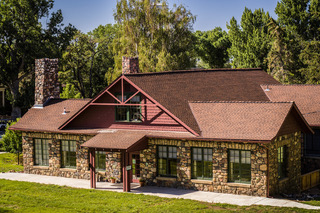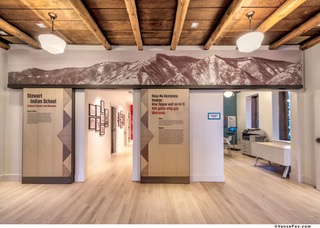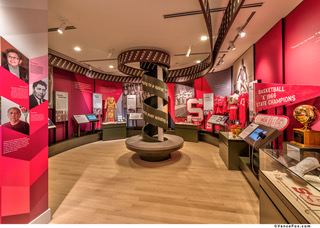Centering Indigenous voices at the Stewart Indian School Cultural Center & Museum
08 April 2021 – Linda Eben Jones, Chris Ann Gibbons, Bobbi Rahder and Samantha Williams
In January 2020, the Stewart Indian School Cultural Center & Museum opened in Carson City, Nevada. Since the boarding school’s closure in 1980, former students and their families had urged the state of Nevada to commemorate alumni experiences as a means of recognizing their trauma and need for healing. After decades of Indigenous advocacy, the Stewart Indian School Cultural Center & Museum addresses these concerns and shares the history of the school through the voices and perspectives of boarding school survivors. To underscore the importance of this approach, Stewart Indian School alumna Linda Eben Jones’ reflections of her time at the school and her evaluation of the museum are integrated throughout this essay.

Stewart Indian School Cultural Center and Museum Photo credit: Stewart Indian School Cultural Center & Museum
“At my first visit to the newly opened Stewart Indian School Cultural Center and Museum, I saw our class of 1966 graduation photo. I recalled my graduation day and the happiness I felt to finally leave this school. I have good and bad memories of Stewart. I have many good memories of friends I met, a couple of good teachers, and dormitory matrons who helped us survive this place. The friends, teachers, and dorm matrons all had an impact on my life and I am grateful for that.” Linda Eben Jones, Stewart Indian School Class of 1966, Paiute
The Stewart Indian School was part of a nationwide program that began in 1879 of forcibly removing American Indian children from their families and placing them in off-reservation boarding schools across the country. The schools were intended to assimilate and “civilize” Native children into white society. These federally operated boarding schools enforced strict rules and harsh discipline; students wore uniforms, marched to their classes, and participated in drills. Many students experienced abuse at boarding schools and generations of children were devastated by the separation from their families. This trauma continues to affect many Indigenous communities.
The Stewart Indian School opened in Carson City in December 1890. Initially, school officials removed students from the Washoe, Western Shoshone, and Northern and Southern Paiute nations in Nevada to attend Stewart. Over time, students from 200 nations across the West and Southwest attended. Student experiences varied depending on when they attended, their age, and their proximity to family during their enrollment. Though boarding schools like Stewart became less strict over time, they remained focused on assimilating Native students into mainstream society.
“My family attended Stewart. My father graduated in 1938, my mother in 1941, my brother in 1966, and my sisters in 1972 and 1974. We all had different memories of Stewart; my father never spoke too much about this school. He was kidnapped from Fort Bidwell when he was about ten years old and so he didn’t share his memories with me. My mother talked about working in the bakery and the laundry. My sisters and younger brother have good and bad memories. They had better experiences and better classes than I did.” ~Linda Eben Jones
After the school closed in 1980, the state of Nevada took control of the Stewart campus. Two buildings were dedicated to the preservation of Stewart’s history, and a small museum operated on the campus until 2001. In 2003 the Nevada Indian Commission (NIC), which oversees relations between the Nevada government and the 27 tribal nations, bands, and colonies in the state, moved from Reno to a building on the Stewart campus. In 2008, the NIC established the Stewart Indian School Trail, a self-guided walking tour of the campus that allows visitors to listen to alumni stories about the school.
At the same time, the NIC lobbied state officials to fund a permanent museum on the school grounds. These efforts paid off in 2015, when the Nevada state legislature funded two positions, a museum director and curator, for a museum. Two years later, the state legislature approved $4.5 million to transform the former Stewart administration office into the main museum building, and the former school post office into a welcome center.

Stewart Indian School Cultural Center & Museum Lobby Photo credit: Stewart Indian School Cultural Center & Museum
The museum director and curator worked directly with Stewart alumni and their families to create and design the museum. Staff also contracted with a researcher to locate Stewart’s records and assist with text label writing, and with Great Basin Native artists to help create design elements for the museum.
From the start, the museum focused on sharing the full range of alumni experiences, positive and negative. The museum thus displays examples of student athletic and academic successes alongside accounts of deaths, abuse, and strict discipline. Exhibits use quotations from oral history interviews with Stewart alumni to illustrate how every student’s experience was different. Touch screens share the students’ words and voices, so visitors engage on an aural level as well as visual. And the four Great Basin language groups are represented on exhibit panels and in a language immersion room with language speakers saying, “This is our home,” because Stewart became their second home.
“I sat in the museum’s reflection room and thought about how important it is when I walk into the main exhibit and gasp at the large mural of the boys in the buckboard, because that is how my father arrived at Stewart in the 1930’s. I see the impact the students made in sports. I look at the timeline of history about the boarding school and am glad that these chosen words are correct. ” ~Linda Eben Jones
Native American communities know this history. The same is not true for most non-Native visitors, many of whom have never heard of Native American boarding schools. The museum thus has a dual mission of ensuring that alumni are heard and contextualizing this history as it relates to broader patterns of U.S. colonization. The museum is designed so visitors encounter panels on the invasion of the Americas, genocide, and the repeated efforts to destroy Indigenous cultures immediately upon entering the main exhibit area. Panels also define the concept of “intergenerational trauma” and explain the pain boarding school survivors and their families continue to experience as a result of this history.

Stewart Museum Galleries Photo credit: Stewart Indian School Cultural Center & Museum
Before leaving the main exhibit space, visitors encounter a panel emphasizing the failure of assimilation programs at boarding schools, and the survival of Indigenous languages and cultures. They are also reminded of the sovereignty and resiliency of American Indians, as well as their resolve to heal from the brutal impacts of the boarding school system. By emphasizing alumni experiences and telling the truth about boarding school history, the Stewart Indian School Cultural Center and Museum honors the trauma experienced by former students, and their survivance. So we will conclude with not our words, but theirs.
“I consider myself as a survivor of the boarding school…I have three generations of family alumni and did not know about the “kill the Indian, save the man” quote by the founder of the first boarding school, Henry Pratt. I did not know about cultural genocide until way later in life when I took classes at the Institute of American Indian Arts. I firmly believe that America should be teaching mandatory Native American history, as we had to learn all about American history. Otherwise, we are still invisible to the average American and we have contributed so much to the framework of this country and to the people.” ~Linda Eben Jones
~Linda Eben Jones (Reno-Sparks Indian Colony, Northern Paiute) is the volunteer coordinator at the Stewart Indian School Cultural Center & Museum. She is a jeweler, beadwork artist, dance regalia maker, and doll maker. She attended the Stewart Indian Boarding School in Carson City, Nevada from 1963-1966 and she is also an Institute of American Indian Arts alumna.
~Chris Ann Gibbons began with the Nevada Indian Commission in 2005 and is the curator for the Stewart Indian School Cultural Center & Museum. Chris is a graduate of Southern Oregon University with a degree in history and has a master’s degree in museum studies from the University of Oklahoma.
~Bobbi Rahder is the museum director for the Stewart Indian School Cultural Center & Museum. She has a master’s degree in museum studies and is working on a Ph.D. in American Studies from the University of Kansas.
~Samantha M. Williams has a Ph.D. in history from the University of California, Santa Cruz. She worked as a researcher for the Stewart Indian School Cultural Center & Museum during its development and her book on the history of the Stewart Indian School will be published by the University of Nebraska Press in spring 2022.




Good morming. I am trying to find information about my grandmother Gracie Brown that attend this school. Sadly she passed away. I’m trying to find out what year she graduated from there. My number is (928)961-5423 if someone can get back to me.Thank you.